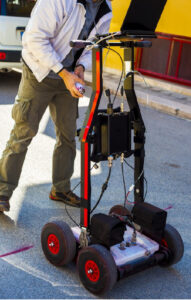GPR, or Ground Penetrating Radar, is an amazing tool with a variety of everyday uses. Many people, however, don’t understand the technology, the process of using it, or its many applications (besides what they see of it in crime dramas). These are some of our most frequently asked questions about GPR.
How Does It Work? Is It Hard To Use?
GPR is a great alternative to simply digging at a site and hoping for the best, but how does it work? For starters, it is a non-destructive imaging method to determine what is buried beneath the surface of the soil. The machine sends out pulses of radar that bounce back once they interact with something buried in the ground. Depending on how long it takes the electromagnetic waves to bounce back, a technician can ascertain how deep an item is beneath the surface as well as what type of item it is. Using the machine is not especially difficult (similar to a walking lawnmower), but learning how to interpret the data can take years of practice and training.
Can GPR “See” Non-Metallic Things?
GPR can detect both metal and non-metal items in the ground. It is used to detect metal tanks as well as plastic lines and wire conduits. GPR can even be used to find gravesites since it detects the changes in the soil composition that occur with excavation.
What Can GPR “See” Through?
GPR waves can travel through most materials, including soil, concrete, ice, and most water. The waves won’t travel through saltwater, but freshwater does not pose an issue. The characteristics of the material can influence how deep the waves can go, however. IF the soil is dry and sandy, the waves can travel deeper than if the soil is wet clay.
Is GPR Safe?
Ground penetrating radar is incredibly safe for both the technician and people around the site. The process emits less power than a cell phone. Speaking of cell phones, the GPR equipment won’t damage yours. However, if your antenna isn’t shielded, using your phone could interrupt the process by interfering with the signal.
Does GPR Make A Picture?
The image that results for ground penetrating radar does not form a visual picture. Rather the size, shape, and sequence of lines can be interpreted by a GPR professional to determine what is under the ground and where. This is why the average person can’t accurately use GPR even if they have a machine.
Concrete Visions Will Get The Job Done Right
Concrete Visions has been working with clients for over 25 years. Our G&M Services installers are certified with the industry’s major firestop product manufacturers. As part of our firestop service, we can assess abnormal field conditions and, with the manufacturer’s technical support assistance, provide engineering judgments in a timely fashion to comply with contract specifications. Our Field Mechanics undergo ongoing training, including mandatory monthly safety meetings, weekly Toolbox Talks where safety and equipment information is shred, and trainings on safe work standards and safety best practices.

